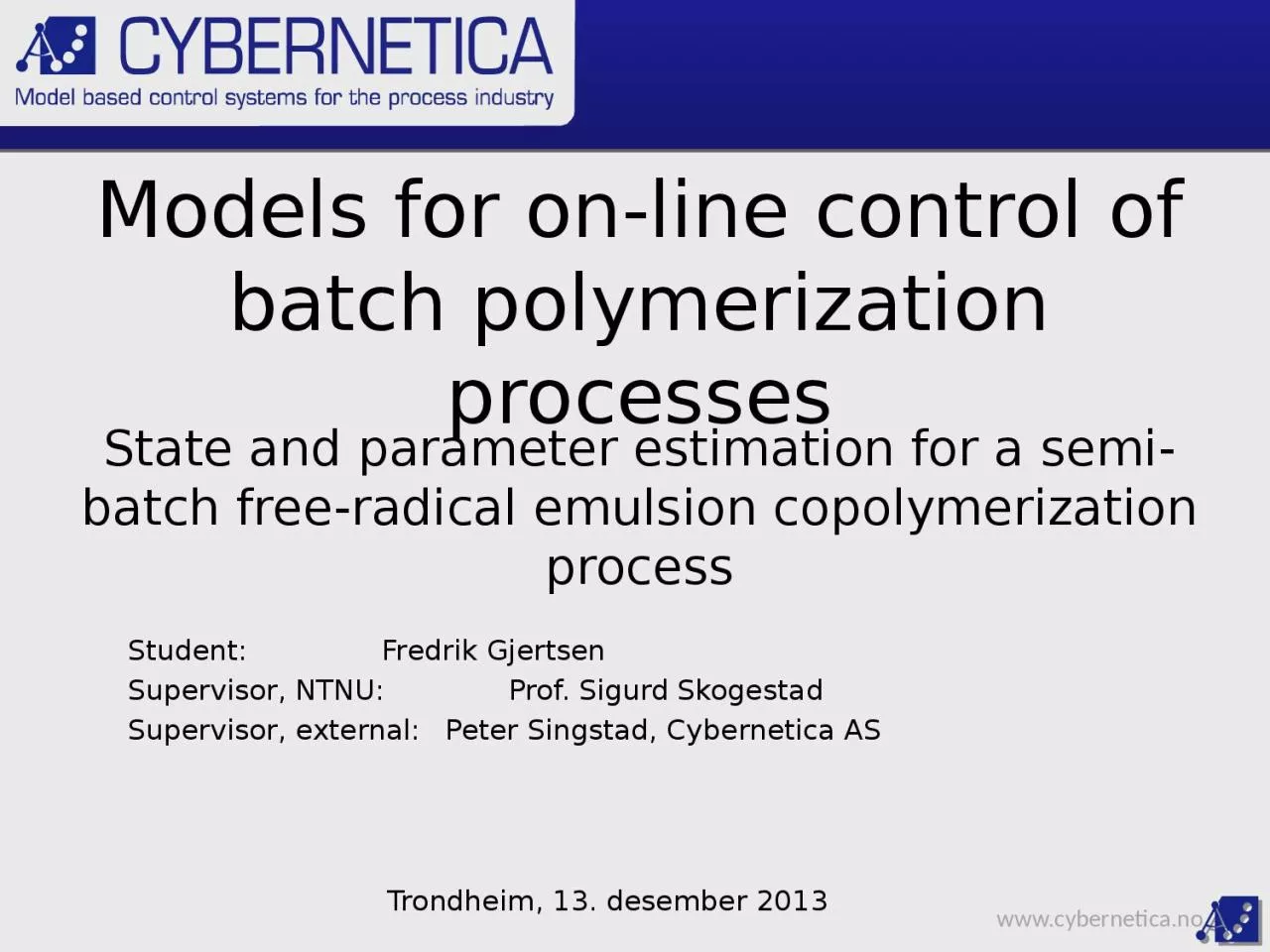

of batch polymerization processes Student Fredrik Gjertsen Supervisor NTNU Prof Sigurd Skogestad Supervisor external Peter Singstad Cybernetica AS State and parameter ID: 1012627
Download Presentation The PPT/PDF document "Models for on-line control" is the property of its rightful owner. Permission is granted to download and print the materials on this web site for personal, non-commercial use only, and to display it on your personal computer provided you do not modify the materials and that you retain all copyright notices contained in the materials. By downloading content from our website, you accept the terms of this agreement.
1. Models for on-line control of batch polymerization processesStudent: Fredrik GjertsenSupervisor, NTNU: Prof. Sigurd SkogestadSupervisor, external: Peter Singstad, Cybernetica ASState and parameter estimation for a semi-batch free-radical emulsion copolymerization processTrondheim, 13. desember 2013
2. AgendaMotivation and overview: MPCModel descriptionThe need for estimationResults from off-line parameter estimationConclusions from the workLooking forward: A proposal for an extension to the work2
3. Components of an MPC implementation3
4. Typical development process4(In my case: Approximately one year)
5. Components of an MPC implementation5Initially: A process of interest – Free-radical emulsion copolymerizationStep 1: Acquire a process modelStep 2: Verify and improve the process model through parameter fittingUltimate goal: A complete package including all the necessary components
6. Model descriptionFree-radical emulsion copolymerizationMonomers: Styrene, Butyl acrylateMulti-component, multi-phase, reactive chemical systemSemi-batch reactor setupThe model is formulated in lab-scaleThe model was formulated using the Modelica programming language and implemented using the Dymola software.Parameter fitting was performed using the Cybernetica ModelFit software.6
7. Estimator algorithmsStates and parameters of the model is only known with a certain accuracyOff-line parameter fitting prior to on-line implementationOn-line state and parameter estimation (filtering)The estimator is a key component in the model-based controller implementationH∞-methods, Moving Horizon Estimator, etc.Kalman Filter estimator has been chosenExtended to apply for nonlinear systems7
8. Components of an MPC implementation8
9. Strategy for parameter fitting9Off-line parameter estimation is done using experimental dataTypical optimization problem: fk: Model output at time k ym,k: Measurement at time k θ: The entire collection of parameters φ: Parameters chosen for optimizationSimilar to the method of least squares.lsqcurvefit in MATLAB
10. Results – Reactor temperature 10(Initial behavior)
11. Results – Conversion of monomer 11(Initial behavior)
12. Results – Conversion of monomer 12(With optimally fitted parameters)
13. Results – Molecular weight distribution13(Initial behavior)
14. Results – Molecular weight distribution14(With optimally fitted parameters)
15. ConclusionsSome parameters have been adjusted to improve the modelFactors governing the chemical reaction ratesFactors governing termination of growing polymer chainsFactors governing heat transfer remain untouchedDemand for computational power is highMaybe too high?Include simplifications for on-line implementation?The established formulations for on-line estimation can be applied in the on-line controller implementation15
16. Suggestions for further workComplete the MPC setup for a semi-batch caseTune estimator based on project workDesign and tune controller algorithmExtend the established work to include continuous reactor cases«Smart-scale» tubular reactorsThis will require more modeling work, but most of the theory is reapplicableDesign and tune both estimator and controller, using experimental data for tubular reactors16